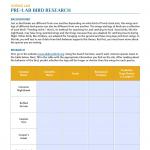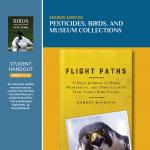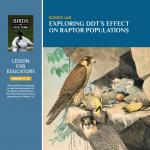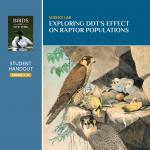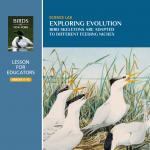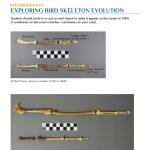Educator Guides (PDFs)
Science Lab: Pre-lab Bird Research (PDF)
Just as bird beaks are different from one another depending on what kind of food a bird eats, the wings and legs of different bird species can also be different from one another. The wings and legs of birds are a refection of each bird’s “feeding niche,” that is, its method for searching for and catching its food. Some birds, like the nighthawk, may have long, pointed wings and short legs, because they are adapted for catching insects during fight. Other birds, like chickens, are adapted for foraging on the ground and have long legs and short wings. In this lab, you will test to see if data from bird skeletons supports this theory. But frst, you must learn more about the species you are testing.
Teacher Guide: Pesticides, Birds, And Museum Collections (PDF)
The twentieth century witnessed the use of new chemicals to address technical and social problems—but many of these same applications had detrimental effects on the natural environment. This lesson is based on the text of our newly renovated exhibit and excerpts from the book Flight Paths: A Field Journal of Hope, Heartbreak, and Miracles with New York’s Bird People, by Darryl McGrath, published by SUNY Press in 2016 to explore DDT’s effect on raptor reproduction, while exercising students’ abilities to read and understand scientific literature. This classroom activity can be used as a Living Environment or English Language Arts lesson, and is appropriate for Grades 6–12 and meets science standards.
Student Guide: Pesticides, Birds, And Museum Collections (PDF)
An interactive reading exercise based on excerpts from the New York State Museum’s exhibit Birds of New York and the book Flight Paths, by Darryl McGrath.
Teacher Guide: Exploring DDT’s Effect On Raptor Populations (PDF)
While exploring this lab, students will build an understanding of how the agricultural pesticide DDT caused populations of many bird species to crash by causing eggshell thinning. Additionally, students will learn about museum specimen collections and how egg specimens were used to establish the links between population declines, eggshell thinning, and DDT exposure.
Student Guide: Exploring DDT’s Effect On Raptor Populations (PDF)
Raptor populations were declining. How did scientists determine what was causing the decline?
Teacher Guide: Exploring Evolution: Bird Skeletons Are Adapted to Different Feeding Niches (PDF)
In this activity, we ask students to interpret the results of their skeleton comparisons within the framework of convergent evolution and adaptation to different feeding niches. The avian skeleton has been modified by natural selection as species have adapted to specialized feeding niches. The repeated evolution of similar morphologies in distantly related species is evidence of the power of natural selection to produce adaptations. These concepts support New York State P–12 Science Learning Standards.
Student Guide: Exploring Evolution: Bird Skeletons Are Adapted to Different Feeding Niches (PDF)
In this portion of the lab we are going to examine the ways that bird morphology (body shape) is adapted to different feeding niches. We will measure wing and leg bones from species with different foraging behaviors. We will interpret the results in the context of convergent evolution, which is the process where multiple species independently evolve similar traits although they are not closely related on the phylogenetic tree.
Exploring Bird Skeleton Evolution: Specimen Photos (PDF)
View specimen photos.


